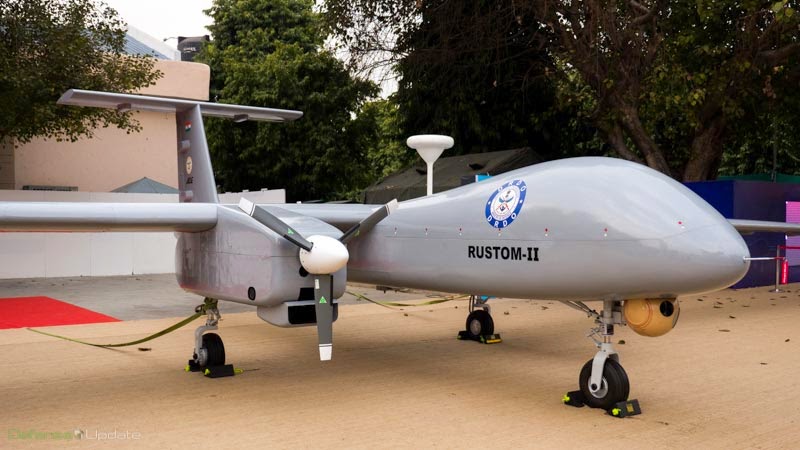Next generation unmanned aerial vehicle Rustum2, which is capable of operating at an altitude of 30,000 feet and 24-hour endurance with a payload of 350 kg, will be made available within a year, Defence Research and Development Organisation (DRDO) Secretary Avinash Chander said on Tuesday.
The UAV would be used for defence operations, including reconnaissance and target identification.
Delivering the 27th Intelligence Bureau Centenary Endowment Lecture on “Emerging Technological Challenges for National Security,” Dr. Chander said the UAV was capable of carrying sensors like aperture radar, maritime patrol radar, communication and electronic intelligence, optical and infrared imagery sensors, including those developed indigenously.
While the Nishant UAV is already in use by security forces, the RUSTOM1, with a capability of 7-8 hours of endurance is also ready. While aerostats, which operate at an altitude of 1 km for surveillance activities, have already been developed, a team of young scientists is working on lighter aerial platforms with a capability to fly at 60,000- 70,000 feet.
“High energy weapons, capable of destroying/disabling systems at tens of kilometres, are going to be vital. Unmanned Ground Vehicles will be participating in intelligent missions capable of identifying and distinguishing between friendly and enemy systems with proper signature management,” said Dr. Chander, adding that advanced data compression techniques have enabled soldiers to transmit video imagery through hand-held devices.
Space security infrastructure
Dr. Chander also flagged the necessity to strengthen space security infrastructure. “To achieve self-reliance in the satellite navigation system, India is establishing the Indian Regional Navigation Satellite System with dependents from across all the services. It is necessary to safeguard such system of national importance...space assets are vulnerable to electronic warfare like jamming, laser attacks, killer micro-satellites,” he said.
The DRDO Secretary said inclusion of futuristic technologies would revolutionise the intelligence infrastructure.
He also talked about foray into areas of nanotechnology and micro-electromechanical systems operated wirelessly on a computer network for sensing through radio-frequency identification, besides convergence of nanotechnology, biotechnology, information and cognitive technology.
Keywords: Rustum2, unmanned aerial vehicle, DRDO, Defence Research and Development Organisation, Avinash Chander, DRDO Secretary, 27th Intelligence Bureau Centenary Endowment Lecture, 'Emerging Technological Challenges for National Security', Nishant UAV, RUSTOM1
Source:THE HINDU
The UAV would be used for defence operations, including reconnaissance and target identification.
Delivering the 27th Intelligence Bureau Centenary Endowment Lecture on “Emerging Technological Challenges for National Security,” Dr. Chander said the UAV was capable of carrying sensors like aperture radar, maritime patrol radar, communication and electronic intelligence, optical and infrared imagery sensors, including those developed indigenously.
While the Nishant UAV is already in use by security forces, the RUSTOM1, with a capability of 7-8 hours of endurance is also ready. While aerostats, which operate at an altitude of 1 km for surveillance activities, have already been developed, a team of young scientists is working on lighter aerial platforms with a capability to fly at 60,000- 70,000 feet.
“High energy weapons, capable of destroying/disabling systems at tens of kilometres, are going to be vital. Unmanned Ground Vehicles will be participating in intelligent missions capable of identifying and distinguishing between friendly and enemy systems with proper signature management,” said Dr. Chander, adding that advanced data compression techniques have enabled soldiers to transmit video imagery through hand-held devices.
Space security infrastructure
Dr. Chander also flagged the necessity to strengthen space security infrastructure. “To achieve self-reliance in the satellite navigation system, India is establishing the Indian Regional Navigation Satellite System with dependents from across all the services. It is necessary to safeguard such system of national importance...space assets are vulnerable to electronic warfare like jamming, laser attacks, killer micro-satellites,” he said.
The DRDO Secretary said inclusion of futuristic technologies would revolutionise the intelligence infrastructure.
He also talked about foray into areas of nanotechnology and micro-electromechanical systems operated wirelessly on a computer network for sensing through radio-frequency identification, besides convergence of nanotechnology, biotechnology, information and cognitive technology.
Keywords: Rustum2, unmanned aerial vehicle, DRDO, Defence Research and Development Organisation, Avinash Chander, DRDO Secretary, 27th Intelligence Bureau Centenary Endowment Lecture, 'Emerging Technological Challenges for National Security', Nishant UAV, RUSTOM1
Source:THE HINDU




